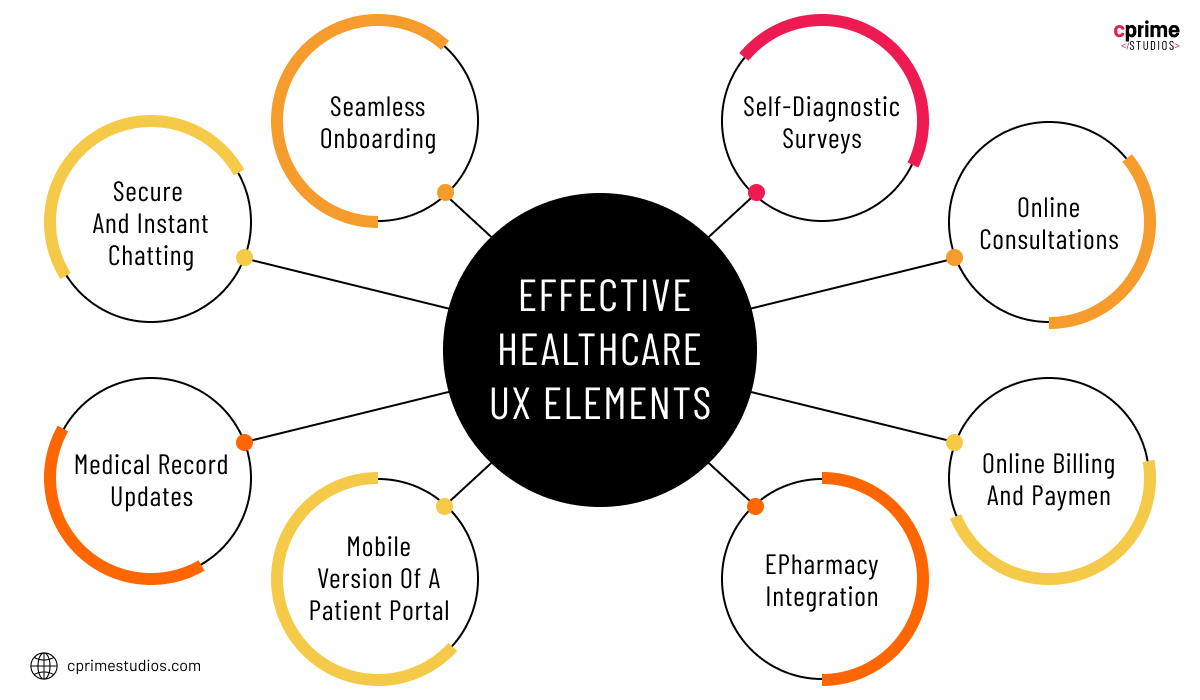Effective Healthcare UX Tactics to Enhance Patient Portal Engagement
The reason for the low utilization of patient portals might be in the poor healthcare UX (user experience) they provide, In this article, we suggest reviewing the performance of your current solution and utilizing effective tactics to improve your healthcare portal engagement.
The majority of patient portals may seem too complicated for users to operate, but everything gets better when owners decide to pay more attention to the usability of their portals. The problem is that your desire to cram all the data in one place often leads to a churn of users from your patient portal. Consequently, you need to redesign or build from scratch a patient portal with a focus on user-friendliness.
In 2018, 90% of 1,800 survey respondents confirmed that their healthcare institution had a patient portal. Patient online services were already pretty well established then and have since become an even more essential part of medical care, but neither all hospitals nor patients use them effectively.
WHAT ARE THE GOALS OF A PATIENT PORTAL?
A healthcare portal can provide the following benefits, which are essential for hospitals and patient care:
Instant access to healthcare services. Online patient portals allow for accessing medical services instantly, which is essential in areas where the quality of medical services is low or average but an Internet connection is available.
Staying in touch with a healthcare professional. Using a health portal to stay in touch with your physician in case there are urgent or additional questions is much more effective than scheduling a consultation or even calling every time you need to clarify something.
Keeping medical information organized, updated, and easily accessible. Most patient portals are integrated with an Electronic Health Record (EHR) system, so patients have the opportunity to stay updated (for example, on their lab test results), and keep all the information stored securely in one place.
Optimizing doctor schedules and cutting costs for hospitals. Scheduling a consultation online is one of the most essential features of a patient care portal. This is also a core opportunity for optimizing a doctor’s time and cutting hospital costs on employee downtime and/or maintaining additional staff for schedule management.
Promoting a responsible attitude to one’s health. When healthcare services are accessible, patients have fewer excuses for not paying attention to their health issues. What’s more, good patient portals are often enriched with self-care tips and advice from medical professionals.
COMMON PATIENT PORTAL FEATURES
To help the hospital and its patient achieve their above goals, an online patient portal should have the following features:
Registration. This is a feature to get users started, however, the wrong approach to its development may be the reason for low patient engagement with the portal.
Consultation scheduling. This is a core feature that allows a patient to schedule a meeting with a doctor, and for the doctor to plan and manage their schedule in advance.
Medical records. With the help of this feature, patients and doctors can stay updated on changes in the patient’s health, revise treatment programs and take timely measures to keep patients healthy.
Healthcare tips. This section is also important for a patient portal since educating patients and teaching them preventive measures is always a better alternative to having to treat medical issues.
KEY BARRIERS OF PATIENT PORTAL USABILITY
Having the above features as a part of your patient portal doesn’t mean it has a good usability and will provide an engaging healthcare UX. There are also some barriers that can lead to ineffective patient portal development. Below are the most common issues that directly affect usability in healthcare:
Security issues. Creating a patient portal requires legal and security compliance. Following the Health Insurance Portability and Accountability Act (HIPAA) is only one of the requirements. Complying with the others means a lot of work needs to be done and a lot of time and money needs to be invested in compliance. Since a patient portal often deals with sensitive medical information, there is also a need for additional security technologies that some hospitals find challenging to implement and fund.
Financial issues. Financing patient portal development and maintenance is one more reason why some solutions are still under development or have been launched half-baked. None of the options in underdeveloped portals allow for the implementation of a good healthcare UX and engagement.
Hospital’s readiness to adopt tech solutions. There are a lot of aging hospitals whose leadership doesn’t see the economic feasibility of investing in new technologies when they are facing bigger issues they deem a priority.
Patients’ willingness to use a patient portal. You might be surprised to find out that according to research in 2018, 70% of patients preferred to speak to their doctor directly, 57% felt that they have no need for a medical portal and 22% had privacy concerns. Those numbers may have improved since, but developing an efficient and engaging patient portal is not possible without feedback from patients, and in some cases, you may find that your patients are just not ready for change.
How to get your medical mobile app HIPAA certified
HOW TO CHECK THE CURRENT USABILITY AND ENGAGEMENT LEVEL OF YOUR PATIENT PORTAL
Before trying to improve the engagement level of your patient portal, you should identify the issues that slow it down. Below are the steps that must be taken to determine this.
Find out the bounce rate. Since a patient portal works like any other website (but only with an enhanced level of medical data security), it makes sense to start by checking the bounce rate. This figure refers to the percentage of the users that have left the page shortly after logging in. The bounce rate is calculated by the total number of logins to a website divided by the total number of single-page visits, and it can be found in Google Analytics. A high bounce rate means the users are unwilling to interact with the portal much after signing in. The reasons may be an outdated healthcare UX design or a non-intuitive user interface where the users can’t find the section they need.
Take a look at the design. Regardless of the bounce rate, you should take a look at the UX design of your healthcare portal. The first impression your patients get is visual, and that’s why you need to keep your healthcare UX design modern and aesthetically pleasing. For example, look at the minimalistic design of Google Health, the clarity of the information it provides, and the use of white space.
Correlate the number of pre-booked consultations with the number of actual patients seen. This figure will help you figure out whether your patient portal is as effective as you want it to be. In a perfect world, 90% of pre-booked consultations are realized in real life or online patient visits.
Revise the response rate. Slow response or no response is one of the top complaints of patients who use a portal. Getting in touch with a healthcare institution is the goal, so no response or a slow one may badly affect engagement even if there is good technical usability.
Ask your patients for feedback. Asking your patients to share their impressions from interacting with a patient portal is one of the best strategies to see how you can improve the user experience in healthcare. Since they are your end-users, taking their suggestions into account and improving the platform according to their wishes is usually a winning approach.
Effective Healthcare UX elements

EFFECTIVE HEALTHCARE UX ELEMENTS
After getting a clear picture of usability and UX in healthcare, you can proceed with implementing some improvements that will positively affect your patient portal performance and attract new patients. Below are the most essential elements that contribute to a positive healthcare UX with your patient portal.
Seamless onboarding. Asking for too much data at the registration stage can be one reason for a high bounce rate so facilitate this process by limiting the number of initial questions to critical ones like name, age, and email or phone number. Allow the patient to fill in additional information later.
Secure and instant chatting. To solve slow response rate issues and improve the healthcare UX, including an instant chat feature. All correspondence should be secured and protected according to the practices established by HIPAA. Doctors can’t spend their valuable time dealing with standard online questions from patients, so introducing a chatbot able to deal with simple requests can be effective.
Medical record updates. Keeping medical information updated is essential for high patient portal engagement since it allows both doctors and patients to keep track of health changes and act in a timely fashion.
Mobile version of a patient portal. The concept of mobile health (mHealth) covers a lot of solutions that allow patients to use their mobile devices in their healthcare maintenance. A patient portal is no exception, so in 2021, having a mobile version of your patient portal is a must in order to engage a tech-savvy generation of users accustomed to solving their everyday needs with the help of their cell phones.
Self-diagnostic surveys. Adding self-diagnostic tools will not only improve engagement in your patient portal, it will also allow doctors to save time spent on initial examinations and symptom analysis. This feature is especially useful for patients with anxiety because they can get preliminary results as soon as they are available.
Online consultations. This is one more engagement-boosting feature. It is especially relevant in pandemic times since, according to news outlets like NBC, people were afraid to visit hospitals because of the risk of being infected with Covid-19. Online consultation is a safer and equally effective option for treating non-critical conditions, providing mental health services, and chronic disease management.
Online billing and payment. These features are essential for patient portal engagement improvement since they allow patients to have full medical service in one place. According to research, 80% of patients surveyed in 2018 were interested in paying for their healthcare with the help of a mobile app, and that number has only increased since. This is one more argument in favor of developing a mobile patient portal with online billing and payment built-in.
ePharmacy integration. Your users might appreciate the opportunity to order the medicines they need on the patient portal website or after being redirected to a page for the online pharmacy you partner with.
WHY YOU SHOULD ADD GAMIFICATION TO YOUR PATIENT PORTAL
Should you add gamification features to improve the healthcare UX and boost the engagement of your patient portal?
Gamification is believed to be effective for keeping users engaged, but how do you integrate it with medical services? In this case, you need to be creative while continuing to make your patients’ health a priority.
You might want to offer your patients rewards for taking pills on time and recording it in their profile or in a mobile patient portal app, for instance. Or you may help them develop healthier habits, follow a doctor-prescribed diet, or go for a one-hour walk every day.
CONCLUSION
Creating a good patient portal with strong technology is only half the job. The other half is making it engaging, secure, legally compliant, and ensuring it meets the needs of your patients.
Our technical team can help you create a patient portal from scratch using best industry practices, or offer solutions to improve the portal you already have in place. Feel free to reach out to us at learn@cprime.com if you need help with some of the issues we have covered in this article!


